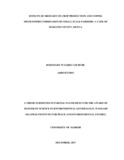| dc.contributor.author | Gichure, Rosemary W | |
| dc.date.accessioned | 2017-12-18T12:08:40Z | |
| dc.date.available | 2017-12-18T12:08:40Z | |
| dc.date.issued | 2017 | |
| dc.identifier.uri | http://hdl.handle.net/11295/102007 | |
| dc.description.abstract | Drought has adversely affected Kenyan agricultural production. This is evident as Kenya experiences extreme droughts every ten years and less adverse ones every three to four years .Although some mitigation technologies have been employed to reduce food scarcity across the board. However, the situation of food insecurity continues to be a major challenge and sometimes even worsens among human livelihoods.
This study seeks to assess farmer‟s access to food in the face of drought, to determine how farmers‟ attitudes to drought determine their vulnerability or resilience. To assess farmers‟ perceptions on drought adaptation mechanisms and determine drought adaptation mechanism undertaken by farmers in the study area The researcher also was able to widely examine other literature documented on how drought has greatly affected food production globally, in the African region, in Kenya and finally narrowed down to Makueni County formally Makueni district. A cross-sectional descriptive survey was conducted t for the research where Data was collected by use of a questionnaire, an observation checklist and key informant interview guide. Data analysis was done using SPSS (version11.5). The adaptation mechanisms employed by farmers was found to be planting of drought resistant varieties and use of irrigation though the use of irrigation was very low which prompted the researcher to advice that there was need in future to carry out a study and verify whether use of irrigation was effective and reduced food insecurity in the study area. It was equally found that majority of household heads and principal care givers had up to primary level of Education (63%) a status that contributed to low uptake of adaptation measures recommended by research Institutions and experts and therefore contributing to household food insecurity. Majority of households had a higher number of household members (6 members per household) which was higher than the national household members (4 members per household) a situation that equally contributed to a status of food insecurity. Maize was found to be the main source of food among households where it was mainly sourced from the market as opposed to own production a situation that contributed to increased poverty levels among households as a higher percentage of their income was used to purchase food. It was therefore recommended that there was need to increased capacity for extension workers to disseminate the most needed information on climate change to farmers because the information that is given by experts such as the Kenya Meteorological department is complex and its packaging is not understood by farmers who are the end users. The entire stated hypothesis was rejected as the hypothesis showed significant relationships. The results obtained was meant to add to the body of knowledge as well as inform policy makers on better ways of adapting to drought by small scale farmers in order to build capacity for implementation and improvement in crop production. | en_US |
| dc.language.iso | en | en_US |
| dc.publisher | University of Nairobi | en_US |
| dc.rights | Attribution-NonCommercial-NoDerivs 3.0 United States | * |
| dc.rights.uri | http://creativecommons.org/licenses/by-nc-nd/3.0/us/ | * |
| dc.subject | Crop Production and Coping Mechanisms | en_US |
| dc.title | Effects of Drought on Crop Production and Coping Mechanisms Undertaken by Small Scale Farmers: a Case of Makueni County, Kenya. | en_US |
| dc.type | Thesis | en_US |



